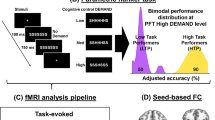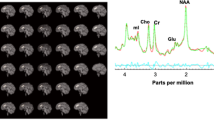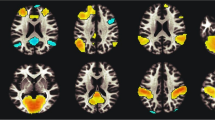Abstract
Prior research suggests that abrupt initiation of abstinence from cigarette smoking reduces neural cognitive efficiency. When cognitive efficiency is high, processing speed and accuracy are maximized with minimal allocation of cognitive resources. The study presented here tested the effects of resumption of smoking on cognitive response conflict after overnight abstinence from smoking, hypothesizing that smoking would enhance cognitive efficiency. Twenty paid research volunteers who were chronic cigarette smokers abstained from smoking overnight (>12 h) before undergoing fMRI while performing a color-word Stroop task during two separate test sessions: one that did not include smoking before testing and another one that did. Statistical analyses were performed by modeling the Stroop effect (incongruent >congruent) BOLD response within a collection of a priori regions of interest that have consistently been associated with cognitive control. Behavioral assessment alone did not reveal any significant differences in the Stroop effect between the two sessions. BOLD activations, however, indicated that in the right anterior cingulate cortex (ACC), smokers had significantly less task-related activity following smoking (p<0.02). In contrast, the right middle frontal gyrus exhibited significantly greater activity after smoking as compared to the no-smoking session (p<0.003). Exaggerated neural activity in the ACC during nicotine withdrawal may reflect a compensatory mechanism by which cognitive control networks expend excessive energy to support selective attention processes. Resumption of smoking may enhance cognitive control in smokers, involving a reduction in ACC response conflict activity together with improvement in conflict resolution involving the dorsolateral prefrontal cortex.
Similar content being viewed by others
Log in or create a free account to read this content
Gain free access to this article, as well as selected content from this journal and more on nature.com
or
References
Al’Absi M, Amunrud T, Wittmers LE (2002). Psychophysiological effects of nicotine abstinence and behavioral challenges in habitual smokers. Pharmacol Biochem Behav 72: 707–716.
Alain C, McNeely HE, He Y, Christensen BK, West R (2002). Neurophysiological evidence of error-monitoring deficits in patients with schizophrenia. Cereb Cortex 12: 840–846.
Beck A, Steer R, Brown G (1996). Beck Depression Inventory—Second Edition manual. The Psychological Corporation: San Antonio, TX.
Becker KM, Rose JE, Albino AP (2008). A randomized trial of nicotine replacement therapy in combination with reduced-nicotine cigarettes for smoking cessation. Nicotine Tob Res 10: 1139–1148.
Beckmann CF, Jenkinson M, Smith SM (2003). General multilevel linear modeling for group analysis in FMRI. Neuroimage 20: 1052–1063.
Bolla K, Ernst M, Kiehl K, Mouratidis M, Eldreth D, Contoreggi C et al (2004). Prefrontal cortical dysfunction in abstinent cocaine abusers. J Neuropsychiatry Clin Neurosci 16: 456–464.
Botvinick M, Nystrom LE, Fissell K, Carter CS, Cohen JD (1999). Conflict monitoring versus selection-for-action in anterior cingulate cortex. Nature 402: 179–181.
Botvinick MM, Cohen JD, Carter CS (2004). Conflict monitoring and anterior cingulate cortex: an update. Trends Cogn Sci 8: 539–546.
Breitling LP, Twardella D, Raum E, Brenner H (2009). Situational temptation scores and smoking cessation in general care. Psychol Addict Behav 23: 362–367.
Bush G, Frazier JA, Rauch SL, Seidman LJ, Whalen PJ, Jenike MA et al (1999). Anterior cingulate cortex dysfunction in attention-deficit/hyperactivity disorder revealed by fMRI and the Counting Stroop. Biol Psychiatry 45: 1542–1552.
Bush G, Luu P, Posner MI (2000). Cognitive and emotional influences in anterior cingulate cortex. Trends Cogn Sci 4: 215–222.
Carter C, Braver T, Barch D, Botvinick M, Noll D, Cohen JD (1998). Anterior cingulate cortex, error detection, and the online monitoring of performance. Science 280: 747–749.
Carter CS, Macdonald AM, Botvinick M, Ross LL, Stenger VA, Noll D et al (2000). Parsing executive processes: strategic vs evaluative functions of the anterior cingulate cortex. Proc Natl Acad Sci USA 97: 1944–1948.
Cohen JD, Servan-Schreiber D, McClelland JL (1992). A parallel distributed processing approach to automaticity. Am J Psychol 105: 239–269.
Domier CP, Monterosso JR, Brody AL, Simon SL, Mendrek A, Olmstead R et al (2007). Effects of cigarette smoking and abstinence on Stroop task performance. Psychopharmacology (Berl) 195: 1–9.
Durston S, Davidson MC, Thomas KM, Worden MS, Tottenham N, Martinez A et al (2003). Parametric manipulation of conflict and response competition using rapid mixed-trial event-related fMRI. Neuroimage 20: 2135–2141.
Eldreth DA, Matochik JA, Cadet JL, Bolla KI (2004). Abnormal brain activity in prefrontal brain regions in abstinent marijuana users. Neuroimage 23: 914–920.
Forman SD, Dougherty GG, Casey BJ, Siegle GJ, Braver TS, Barch DM et al (2004). Opiate addicts lack error-dependent activation of rostral anterior cingulate. Biol Psychiatry 55: 531–537.
Foulds J, Stapleton J, Swettenham J, Bell N, McSorley K, Russell MA (1996). Cognitive performance effects of subcutaneous nicotine in smokers and never-smokers. Psychopharmacology (Berl) 127: 31–38.
Garavan H, Ross T, Stein E (1999). Right hemispheric dominance of inhibitory control: an eventrelated functional MRI study. Proc Natl Acad Sci USA 96: 8301–8306.
Garavan H, Stout JC (2005). Neurocognitive insights into substance abuse. Trends Cogn Sci 9: 195–201.
Hatsukami D, Fletcher L, Morgan S, Keenan R, Amble P (1989). The effects of varying cigarette deprivation duration on cognitive and performance tasks. J Subst Abuse 1: 407–416.
Heatherton TF, Kozlowski LT, Frecker RC, Fagerstrom KO (1991). The Fagerstrom Test for Nicotine Dependence: a revision of the Fagerstrom Tolerance Questionnaire. Br J Addict 86: 1119–1127.
Heishman SJ (1999). Behavioral and cognitive effects of smoking: relationship to nicotine addiction. Nicotine Tob Res 1 (Suppl 2): S143–S147; discussion S165-S146.
Hester R, Nestor L, Garavan H (2009). Impaired error awareness and anterior cingulate cortex hypoactivity in chronic cannabis users. Neuropsychopharmacology 34: 2450–2458.
Holmes S, Zwar N, Jimenez-Ruiz CA, Ryan PJ, Browning D, Bergmann L et al (2004). Bupropion as an aid to smoking cessation: a review of real-life effectiveness. Int J Clin Pract 58: 285–291.
Hughes JR, Lesmes GR, Hatsukami DK, Richmond RL, Lichtenstein E, Jorenby DE et al (1999). Are higher doses of nicotine replacement more effective for smoking cessation? Nicotine Tob Res 1: 169–174.
Hurt RD, Sachs DP, Glover ED, Offord KP, Johnston JA, Dale LC et al (1997). A comparison of sustained-release bupropion and placebo for smoking cessation. N Engl J Med 337: 1195–1202.
Jarvik ME, Madsen DC, Olmstead RE, Iwamoto-Schaap PN, Elins JL, Benowitz NL (2000). Nicotine blood levels and subjective craving for cigarettes. Pharmacol Biochem Behav 66: 553–558.
Jenkinson M, Bannister P, Brady M, Smith S (2002). Improved optimization for the robust and accurate linear registration and motion correction of brain images. Neuroimage 17: 825–841.
Jenkinson M, Smith S (2001). A global optimisation method for robust affine registration of brain images. Med Image Anal 5: 143–156.
Jorenby DE, Leischow SJ, Nides MA, Rennard SI, Johnston JA, Hughes AR et al (1999). A controlled trial of sustained-release bupropion, a nicotine patch, or both for smoking cessation. N Engl J Med 340: 685–691.
Kaufman JN, Ross TJ, Stein EA, Garavan H (2003). Cingulate hypoactivity in cocaine users during a GO-NOGO task as revealed by event-related functional magnetic resonance imaging. J Neurosci 23: 7839–7843.
Kaufmann L, Ischebeck A, Weiss E, Koppelstaetter F, Siedentopf C, Vogel SE et al (2008). An fMRI study of the numerical Stroop task in individuals with and without minimal cognitive impairment. Cortex 44: 1248–1255.
Kerns JG, Cohen JD, MacDonald III AW, Cho RY, Stenger VA, Carter CS (2004). Anterior cingulate conflict monitoring and adjustments in control. Science 303: 1023–1026.
Kerns JG, Cohen JD, MacDonald III AW, Johnson MK, Stenger VA, Aizenstein H et al (2005). Decreased conflict- and error-related activity in the anterior cingulate cortex in subjects with schizophrenia. Am J Psychiatry 162: 1833–1839.
Killen JD, Fortmann SP, Schatzberg AF, Hayward C, Sussman L, Rothman M et al (2000). Nicotine patch and paroxetine for smoking cessation. J Consult Clin Psychol 68: 883–889.
London ED, Berman SM, Voytek B, Simon SL, Mandelkern MA, Monterosso J et al (2005). Cerebral metabolic dysfunction and impaired vigilance in recently abstinent methamphetamine abusers. Biol Psychiatry 58: 770–778.
MacDonald A, Cohen J, Stenger V, Carter C (2000). Dissociating the role of the dorsolateral prefrontal and anterior cingulate cortex in cognitive control. Science 288: 1835–1838.
Mathalon DH, Fedor M, Faustman WO, Gray M, Askari N, Ford JM (2002). Response-monitoring dysfunction in schizophrenia: an event-related brain potential study. J Abnorm Psychol 111: 22–41.
McLellan AT, Kushner H, Metzger D, Peters R, Smith I, Grissom G et al (1992). The fifth edition of the Addiction Severity Index. J Subst Abuse Treat 9: 199–213.
Milham MP, Banich MT, Webb A, Barad V, Cohen NJ, Wszalek T et al (2001). The relative involvement of anterior cingulate and prefrontal cortex in attentional control depends on nature of conflict. Brain Res Cogn Brain Res 12: 467–473.
Mohanty A, Herrington JD, Koven NS, Fisher JE, Wenzel EA, Webb AG et al (2005). Neural mechanisms of affective interference in schizotypy. J Abnorm Psychol 114: 16–27.
Newhouse PA, Potter A, Singh A (2004). Effects of nicotinic stimulation on cognitive performance. Curr Opin Pharmacol 4: 36–46.
Oldfield R (1971). The assessment and analysis of handedness: the Edinburgh inventory. Neuropsychologia 9: 97–113.
Parrott AC, Kaye FJ (1999). Daily uplifts, hassles, stresses and cognitive failures: in cigarette smokers, abstaining smokers, and non-smokers. Behav Pharmacol 10: 639–646.
Powell J, Dawkins L, Davis RE (2002). Smoking, reward responsiveness, and response inhibition: tests of an incentive motivational model. Biol Psychiatry 51: 151–163.
Pritchard WS, Robinson JH, Guy TD (1992). Enhancement of continuous performance task reaction time by smoking in non-deprived smokers. Psychopharmacology (Berl) 108: 437–442.
Provost SC, Woodward R (1991). Effects of nicotine gum on repeated administration of the Stroop test. Psychopharmacology (Berl) 104: 536–540.
Ridderinkhof KR, Ullsperger M, Crone EA, Nieuwenhuis S (2004). The role of the medial frontal cortex in cognitive control. Science 306: 443–447.
Rusted JM, Caulfield D, King L, Goode A (2000). Moving out of the laboratory: does nicotine improve everyday attention? Behav Pharmacol 11: 621–629.
Rypma B, Berger JS, Prabhakaran V, Bly BM, Kimberg DY, Biswal BB et al (2006). Neural correlates of cognitive efficiency. Neuroimage 33: 969–979.
Shiffman S, Jarvik M (1976). Smoking withdrawal symptoms in two weeks of abstinence. Psychopharmacology (Berl) 50: 35–39.
Shiffman S, Paty JA, Gnys M, Kassel JD, Elash C (1995). Nicotine withdrawal in chippers and regular smokers: subjective and cognitive effects. Health Psychol 14: 301–309.
Smith SM (2002). Fast robust automated brain extraction. Hum Brain Mapp 17: 143–155.
Snyder FR, Davis FC, Henningfield JE (1989). The tobacco withdrawal syndrome: performance decrements assessed on a computerized test battery. Drug Alcohol Depend 23: 259–266.
Strakowski SM, Adler CM, Holland SK, Mills NP, DelBello MP, Eliassen JC (2005). Abnormal FMRI brain activation in euthymic bipolar disorder patients during a counting Stroop interference task. Am J Psychiatry 162: 1697–1705.
Ullsperger M, von Cramon DY (2004). Neuroimaging of performance monitoring: error detection and beyond. Cortex 40: 593–604.
Warburton DM (1992). Nicotine as a cognitive enhancer. Prog Neuropsychopharmacol Biol Psychiatry 16: 181–191.
Ward MF, Wender PH, Reimherr FW (1993). The Wender Utah Rating Scale: an aid in the retrospective diagnosis of childhood attention deficit hyperactivity disorder. Am J Psychiatry 150: 885–890.
Woolrich MW, Behrens TE, Beckmann CF, Jenkinson M, Smith SM (2004). Multilevel linear modelling for FMRI group analysis using Bayesian inference. Neuroimage 21: 1732–1747.
Worsley KJ, Evans AC, Marrett S, Neelin P (1992). A three-dimensional statistical analysis for CBF activation studies in human brain. J Cereb Blood Flow Metab 12: 900–918.
Xu J, Mendrek A, Cohen MS, Monterosso J, Rodriguez P, Simon SL et al (2005). Brain activity in cigarette smokers performing a working memory task: effect of smoking abstinence. Biol Psychiatry 58: 143–150.
Xu J, Mendrek A, Cohen MS, Monterosso J, Simon S, Jarvik M et al (2007). Effect of cigarette smoking on prefrontal cortical function in nondeprived smokers performing the Stroop Task. Neuropsychopharmacology 32: 1421–1428.
Zachary R (1986). Shipley Institute of Living Scale: Revised manual. Western Psychological Services: Los Angeles.
Zang YF, Jin Z, Weng XC, Zhang L, Zeng YW, Yang L et al (2005). Functional MRI in attention-deficit hyperactivity disorder: evidence for hypofrontality. Brain Dev 27: 544–550.
Acknowledgements
This work was supported by NIH grants RO1 DA014093 (EDL) and MOI RR 00865 (UCLA GCRC), UC Tobacco-Related Disease Research Program award 10RT-0091 (EDL), the Philip Morris External Research Program (EDL), an endowment from the Thomas P and Katherine K Pike Chair in Addiction Studies, and a generous gift from the Marjorie M Greene Trust. This paper was presented in part at the annual meeting of the Society for Research on Nicotine and Tobacco in Portland, Oregon, which took place from February 27 to March 1, 2008.
Author information
Authors and Affiliations
Corresponding author
Additional information
DISCLOSURE
Dr London received support for other research from Phillip Morris, USA. The other authors have no financial conflicts of interest.
Rights and permissions
About this article
Cite this article
Azizian, A., Nestor, L., Payer, D. et al. Smoking Reduces Conflict-Related Anterior Cingulate Activity in Abstinent Cigarette Smokers Performing a Stroop Task. Neuropsychopharmacol 35, 775–782 (2010). https://doi.org/10.1038/npp.2009.186
Received:
Revised:
Accepted:
Published:
Issue date:
DOI: https://doi.org/10.1038/npp.2009.186
Keywords
This article is cited by
-
The changes of brain functional networks in young adult smokers based on independent component analysis
Brain Imaging and Behavior (2021)
-
Nicotine dependence (trait) and acute nicotinic stimulation (state) modulate attention but not inhibitory control: converging fMRI evidence from Go–Nogo and Flanker tasks
Neuropsychopharmacology (2020)
-
12-h abstinence-induced functional connectivity density changes and craving in young smokers: a resting-state study
Brain Imaging and Behavior (2019)
-
Exploring the effects of anodal and cathodal high definition transcranial direct current stimulation targeting the dorsal anterior cingulate cortex
Scientific Reports (2018)
-
The thalamo-cortical resting state functional connectivity and abstinence-induced craving in young smokers
Brain Imaging and Behavior (2018)



